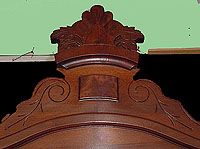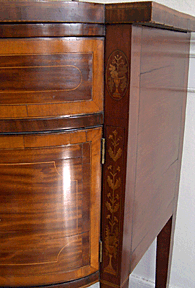Preserving
the Patina–and Value
–of Antique Furniture
by Bob Brooke
 It takes years of experience,
observation, study, and training to differentiate between an
antique piece of furniture and a faithful reproduction. Some
characteristics, however, cannot be reproduced. Perhaps the most
unmistakable one is patina. This is a mellowing of the surface
acquired by wood through age, use, dusting, and polishing. It takes years of experience,
observation, study, and training to differentiate between an
antique piece of furniture and a faithful reproduction. Some
characteristics, however, cannot be reproduced. Perhaps the most
unmistakable one is patina. This is a mellowing of the surface
acquired by wood through age, use, dusting, and polishing.
True
patina is nonexistent on furniture only a few years old. Although fine
mahogany, cherry, or maple, recently milled, may look handsome, they
lack the glow that comes with a century or more of use. The tone or
color of course varies with the wood, but the bloom grows with age and
handling. Restoring and refinishing always must be done carefully to
avoid damaging the patina.
The
natural aging of wood contributes greatly to its patina. Backboards and
drawers made of soft woods also color as they age. When they are taken
out, the upper drawers may still be light-colored because they were
protected. But the backboards and the bottom of the lowest drawer, which
have been exposed, will have darkened and mellowed to a soft shade of
brown. Again, this darkening cannot be reproduced or faked by applying
stain.
 There’s
some controversy when it comes to refinishing a piece of antique
furniture. Purists, especially those collecting 18th and early
19th-Century pieces will argue that to touch a piece is nothing less
than criminal. Others will argue that some pieces need cleaning and
maybe some repair. Collectors of higher-valued furniture want their
pieces to be in pristine–that is, absolutely original--condition. To
them, even cleaning a piece takes away from its value. There’s
some controversy when it comes to refinishing a piece of antique
furniture. Purists, especially those collecting 18th and early
19th-Century pieces will argue that to touch a piece is nothing less
than criminal. Others will argue that some pieces need cleaning and
maybe some repair. Collectors of higher-valued furniture want their
pieces to be in pristine–that is, absolutely original--condition. To
them, even cleaning a piece takes away from its value.
Cleaning a valuable antique can be done, but it should be done by a
professional. Off-the-shelf cleaners and polishes like Pledge do more
harm than good, as they build up a layer of wax and hydrocarbons. For
less valuable pieces, a simple washing mixture can be prepared using a
capful of Murphy’s Oil Soap to about two quarts of warm water. This
should be applied onto a small area at a time using an old washcloth,
followed immediately by a thorough drying with an old terrycloth towel.
The piece should be allowed to dry for about 24 hours before applying a
coating of Minwax. By working on a small area at a time and working
quickly, warping will be prevented.
The
only kind of wax that should ever be used on antique furniture is Minwax
paste wax, applied with a soft cloth such as an old sock or a cloth
diaper. An annual waxing using Minwax preserves and moisturizes the
wood.
To read
more of my articles, please
visit
my Web site.
< Back to Antiques Articles
Next Article >
|
